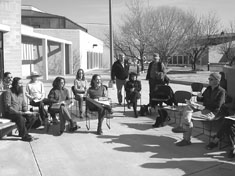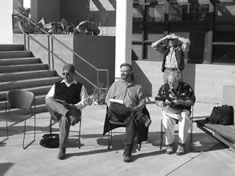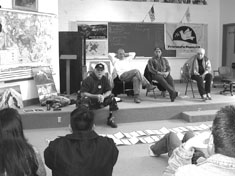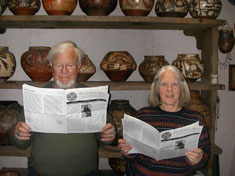 |
|
|
Volume XI |
February 2006 |
Number 2 |
|
|
Forest "Circus" Tackles Invasive Plants By Mark SchillerANNOUNCEMENTSSanta Fe Veterans for Peace "Full Disclosure Recruiting" Team Again Visits Peñasco High School By Kay Matthews |
Interview with Marty Peale, Valles Caldera Coalition Coordinator Which Address Is It, Peñasco or El Valle? |
Forest "Circus" Tackles Invasive PlantsBy Mark SchillerIf the Forest Service, as it constantly claims, is trying to do a better job of engaging the public in its decision making process in order to avoid costly, time-consuming appeals, it sure has a funny way of demonstrating it. The "Invasive Plant Control Project" on the Carson and Santa Fe National Forests is a case in point. The Forest Service received over one hundred comment letters, including a petition with over one thousand signatures, imploring it to avoid using herbicides to address this problem, which it estimates affects less than 7,500 acres over the approximately 3,000,000 acres included in the two forests. So guess what? After months of analysis, costing untold thousands of dollars, the "preferred alternative" included herbicides. And guess what else? The agency received no less than six appeals representing dozens of groups and individuals. But did this deter the Forest Service's tireless efforts to engage the public? Of course not. On January 26 a Forest Service team comprised of ten members, including Carson Forest Supervisor Martin Chávez and Santa Fe Forest Acting Supervisor Cliff Dils, all of whom were being compensated for their time, met with ten of the appellants, none of whom were being compensated for their time, to listen to the concerns the appellants had already expressed in their comment letters and appeals. Are you beginning to detect a pattern here?
Appellants and Forest Service representatives meet on the patio of Northern New Mexico Community College Although I'm making light of the process, the appellants' concerns are very real and the outcome of this project could have a lasting detrimental effect on the forest, the wildlife, and the forest adjacent communities, which happen to include Taos, Santa Fe, and Las Vegas. Let's take a look. First off, it seems apparent to everyone but the Forest Service that using herbicides entails an unacceptable and inappropriate health risk to the public at large, wildlife, native plants, and the agency personnel making the applications. The Environmental Impact Statement (EIS) indicates that the majority of herbicide applications would be in riparian areas, which compounds the risk of poisoning streams and spreading contamination. Many appellants further noted that the Forest Service has a questionable safety record in regard to herbicide use. That record has recently been highlighted by the Southwest Region's "pesticide coordinator" blowing the whistle on unauthorized applications for which he was rewarded by being placed on probation and harassed into early retirement. This concern underscores the appellants' and general public's lack of trust in the Forest Service, which was voiced at the meeting by several people including Northern New Mexico Community College administrator and Rio Arriba Environmental Health Association director, Hilario Romero. Romero said that the Forest Service has a history of telling the public one thing but doing another. He questioned why the public should trust the Forest Service to use herbicides when the agency has such a dismal record with "controlled burns" and suggested its safety record is comparable to Los Alamos National Labs, which he clearly meant pejoratively. Appellants also noted that the approximately 7,300 affected acres represent about two-tenths of one percent of these two forests' total area. Resorting to herbicides to treat a problem of this size amounts to using a sledgehammer to drive in a thumb tack. More importantly, appellants assert that there are many "no risk" methods of treating a problem of this scale such as mechanically cutting plants at a critical stage in their development, manually pulling them, and using short duration, high intensity grazing by goats, sheep, and cattle. Several appellants, including former Forest Service employee Sarah Reeb, noted that the EIS dismissed the use of vinegar "despite the comprehensive USDA and NMSU studies which found that at 5% solution it was highly effective in killing tops on all thistles." Not surprisingly, non-herbicidal methods of eradicating invasive plants account for just three pages in the EIS while herbicidal methods account for approximately 70 pages. Appellants also told the Forest Service that the EIS failed to adequately assess the cumulative impacts of herbicidal use. The National Environmental Policy Act (NEPA) mandates federal agencies to do so, but many watch-dog groups have demonstrated that the Forest Service routinely falls short. In this case, appellants claim the analysis fails to "identify significant cumulative effects to wildlife; assess the cumulative impacts of repeated herbicide applications; disclose the inert ingredients contained in the herbicides and assess their potential effects; assess the potential interaction of the piscicides (fish-killing pesticides) that wildlife management agencies plan to use in the Carson to restore native trout, with herbicides the Forest Service plans to administer; and acknowledge that people with Multiple Chemical Sensitivities have significantly lower tolerance levels for the toxic chemicals contained in herbicides.
Forest Service personnel: Martín Chavez, Carson NF; Cliff Dils, Santa Fe NF; Sandy Hurlocker (standing), Santa Fe NF; and Al Fowler, Santa Fe NF Some appellants claimed that the real emphasis of the Invasive Plants Project should be on prevention, which they said the EIS ignored in all its alternatives. While the Forest Service clearly should have included a prevention strategy in the EIS, appellant Sam Hitt of Wild Watershed, who wrote one of the appeals, and John Horning of Forest Guardians, who signed on to Hitt's appeal, are clearly trying to use this as a rationale to advance their own agendas of eliminating all commercial logging and grazing from public lands by unfairly targeting those activities under this aegis. Ironically, other appellants suggested that both grazing and thinning can be effectively used to control and eliminate invasive plants. The Forest Service decision to use herbicides is also in direct opposition to decisions made by local governmental bodies: Taos County has placed a moratorium on the use of herbicides along county roads, and the City Council of Las Vegas recently voted unanimously to maintain the ban on pesticide use in the Gallinas watershed, which supplies most of its drinking water. At the end of the meeting, Forest Supervisors Chávez and Dils both claimed they were affected by the passion and emotion of the appellants, but thus far they have made no substantive concessions. As I noted at the beginning of this article, the agency continues to assert it's growing more sensitive to public concerns. Apparently agency administrators think that if they proclaim it loud enough and often enough it will become fixed in the public's mind, regardless of their actions. ANNOUNCEMENTSThe Steering Committee of the Taos Regional Water Plan spent the afternoon of January 31 finalizing and ranking alternative strategies for addressing the region's future water needs. Right up there at the top of the list was keeping water in its area of origin (along with protecting acequias and tying growth to the availability of water resources). Kay Matthews, co-editor of La Jicarita News and a protestant to the Top of the World (TOW) water transfer, made a presentation on the status of the transfer application. Santa Fe County seeks to transfer 588 acre feet of water (afy) from Top of the World Farms, in northern Taos County, to the Pojoaque basin to help settle the Aamodt adjudication. The county has a contract to purchase an additional 1,088 afy, also slated for the Aamodt adjudication settlement. Individual and organizational member of the Steering Committee were supportive of joining together to look into filing a protest of this second TOW transfer when it is filed. The Taos County Commission approved a resolution opposing any transfers of water below the Otowi Gage at the February 6 meeting and will be deciding on a resolution to support any TOW protests at their February 20 meeting. • At print time the Water Trust Fund bill, which would appropriate monies for water projects and conservation measures around the state, was making its way through the legislature. The bill asks for $100 million in funding. LETTERSLa Jicarita News: Thank you for your report on Patricia Nelson Limerick's speech at this year's Quivira Coalition Conference. I also found Ms. Limerick's comments interesting, but I disagree strongly with her notion that the "cowboy myth" arouses a positive response in today's world. I've manned the "cowboy icon in the contemporary world" frontlines for many years and am convinced that the cowboy has little credibility in modern America. The cowboy icon is so confused with fantasy that very few - if any - people associate it with agriculture. The definition of cowboys as highly skilled contemporary agricultural workers who are connected to the land and partnered with animals never crosses the public's mind. Instead, the American cowboy is dismissed as a worn-out relic of a bygone era that never really existed - or as a registered trademark logo of the Republican Party. One of the goals of my book [Making a Hand: Growing Up Cowboy in New Mexico] is to help redefine the cowboy as a contemporary agricultural people, to take the cowboy out of Hollywood and bring him back home to the ranch where he belongs. The reality is so much greater than the myth - why isn't it promoted? Why does Patty Limerick, of all people, think Roy and Hopalong will lend credibility to today's ranching community? What do TV gunslingers have to do with modern agriculture? Unfortunately, most cowboys themselves promote the fantasy of blazing six-shooters, John Wayne, and George W. Bush. We've got to stop thinking of cowboys as a symbol of anything. Instead, they are simply farmers on horseback. Until the cowboy icon is based on the wondrous reality, it's of little use to anyone. Gene Peach Santa Fe Veterans for Peace "Full Disclosure Recruiting" Team Again Visits Peñasco High SchoolBy Kay MatthewsSpread out across Roger Badish's classroom floor was a long banner with the pictures, names, and personal information of the more than 2,000 American soldiers who have been killed in Iraq. The Santa Fe Veterans for Peace left the banner on the floor during their presentation "Full Disclosure Recruiting" for sophomores, juniors and seniors at Peñasco High School. This was their second visit to the school - La Jicarita News covered their presentation in May of 2005 - and a significant change had taken place. This time, when they asked the students how many of their families supported the war in Iraq, very few hands were raised.
Tim Origer, Eduardo Krasilovsky, Daniel Craig, and Robert Sinn 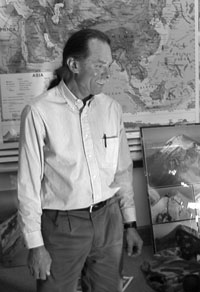
Peñasco High School teacher Roger Badish Daniel Craig, Tim Origer, Eduardo Krasilovsky, and Robert Sinn once again related their personal experiences as military veterans who became aware, each in his own way, of "the Lie: the difference between what we thought we were doing and the reality of what we really were doing." They told the students what the acronym GI actually stands for: "General Issue", meaning when you join the military you become a piece of equipment, not necessarily a person. When one student raised the issue that officers in the military don't have that status, a conversation about class issues ensued. Eduardo Krasilovsky, who was in the Argentinian as well as the Israeli military, explained: "There are two classes of people: the elites, who are the ones who become the generals, and the rest of us, the cannon fodder, very few of whom will make it to general." Minorities often join the military because they believe it will lift them out of poverty and provide a college education. But the vets pointed out that minorities have the highest number of dishonorable discharges, which make them ineligible for college money. Also, the military doesn't have to honor the contracts it signs when you enlist. And ultimately, if you suffer from Post Traumatic Stress Disorder, as so many veterans do, you will no doubt be too sick to go to college, and ultimately, if you die, you don't get to go to college at all. Daniel Craig pointed out that there is 6.6 billion dollars of available college grant money that is left untouched. Tim Origer added that if people want to join the military they should do so after they've gone to college so we have a well informed military that can distinguish between lawful and unlawful activity. Krailovsky told the students that in Argentina, a third world country, he went to college for free. "What's wrong in this country, the richest and most powerful in the world, where many of you can't afford to go to college?" The three goals of the Veterans for Peace are: 1) To heal the wounds of previous wars; 2) To bring existing wars to an end; and 3) To prevent future wars. You can contact Daniel Craig, coordinator of "Full Disclosure Recruiting" at 505 660-6848 or by email at domdanc@yahoo.com. Community Radio in Taos"There's no question that the Taos community is ready for its own public radio station." Robin Collier should know. He and Mike Tilley have donated thousands of hours to public radio via their production company, Cultural Energy: Creating Media Voices for Youth, Arts & Activism in Northern New Mexico. The non-profit production group formed in October of 2003 and set up its studio in January of 2004 (located next door to TaosNet on Camino de la Merced). We've all heard Cultural Energy produced stories, interviews, and programs on Alamosa-based KRZA's "A Las Ocho" program every morning at 8:00, or in longer segments during the day. They're also carried on the University of New Mexico's public radio station KUNM (Youth Media Roundtable) and recently on Taos-based KVOT, from 9 to 10:00 on Saturday and Sunday mornings (the station has also been carrying the mayoral and city council debates). But according to Mike Tilley, "There are too many voices and cultures that are unique to the Taos area that aren't being heard." Geographically, KRZA is too far away to meet the needs of the Taos community, and attempts to create a better collaborative effort between the station and Cultural Energy have not been productive. KVOT is promoting itself as an Air America station and cannot provided the air time to adequately cover Taos stories. So Cultural Energy is looking at the possibility of getting a noncommercial FCC license. "There is no substitute for face to face communication that can be broadcast on radio. That's what is so exciting about local, community radio. It's a personal conversation," Collier says. The group will be holding a series of community meetings over the next few months to solicit input and bring together area organizations that might be interested in helping get a local, public access station off the ground. Ideally, what Collier and Tilley envision, is that each community, from Abiquiu to Mora, Chimayó to San Luis, Colorado, can produce and edit its own programs for the station, which would be based in Taos. Tilley and Collier point out how quickly Miguel Santistevan, who produces the monthly program Que Viven Las Acequias, was able to learn the basics of radio production. "We want to be able to provide immediacy for our listeners, to be there when a fire like the Pueblo fire breaks out, to provide call-in shows, to cover live concerts. We want to be the alternative to the corporate and homogenized news that is taking over our air waves," Tilley says. You can contact Cultural Energy at 505 758-9791 or via email at energy@culturalenergy.org. -
|
Interview with Marty Peale, Valles Caldera Coalition CoordinatorLa Jicarita News: Can you tell us who the Valles Caldera Coalition is and what is its relationship with the Valles Caldera National Preserve? 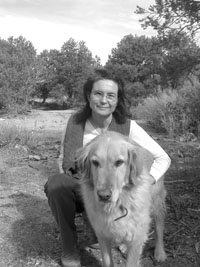
Marty Peale and friend Rio Marty Peale: The Coalition formed in 1997 to lobby for the purchase of the Baca Location to become public land. The law creating the Preserve passed in 2000 and the Coalition decided to stay together, as I understand it [Peale came on board in July 2003], because members were concerned about aspects of the legislation. They wanted to make sure the Preserve was actually protected as the law stipulated. The Coalition was concerned about a presidentially appointed board of trustees, the financial self-sufficiency mandate, and about the requirement that it operate as a working ranch, because as people look around in the West they see a lot of damage on public lands. They wanted to make sure that all these things came together in a way that fulfilled the intent of the legislation. The intent was "to preserve and protect," and to find a better way to make natural resource decisions rather than ending up in court and in a war of attrition between the agencies and people who care about the natural resources. The Coalition has dedicated itself to trying to be helpful in getting this management experiment to work. It's a little bit of a dance to be helpful and collaborative and also retain the option to challenge the Trust when we think they aren't fulfilling the law or doing what's in the public interest. LJN: Who are the members of the Coalition? MP: The Coalition is now 41 members - 28 organizations and 13 individuals - with expertise about resource management, in the Jemez in particular. They include the classic environmental organizations like the Wilderness Alliance, Audubon, Sierra Club, etc., and other organizations that don't characterize themselves as environmental groups but care about the resources, like the National Wild Turkey Federation, Backcountry Horseman's Association, and recreationists like the High Altitude Athletic Club. And La Jicarita News, which specializes in education. LJN: The Preserve has been in the news a lot lately, and most of the press has been negative. Some of the issues being raised are: 1) Financial mismanagement or accounting; 2) Failure to move towards the mandate of sustainability; 3) Antagonism between the ranching and recreationist interest groups; 4) Antagonism between the Preserve Board of Trustees and the staff; and 5) A lack of transparency. Let's look at these issues from your perspective. MP: The first one that jumps out is the ranchers versus the recreationists. I have cautioned the press about framing it that way because I don't see that there has to be a conflict. I don't think it has to be, and I think at best it won't be. There's a permaculture adage that says, 'everything you do should serve more than one purpose.' If we design for recreation and we design for cattle as two separate programs we will be missing catalytic and synergistic opportunities for each of them to function as more than we think they can, on first impression. Yes, there are recreationists who would like to see no cattle at all on the Preserve, but that's not the majority, and I don't think that means there has to be a conflict. For instance, one option we've tried to keep open is zoning the Preserve for management with different priorities in different areas. You might look at it like diversifying your stock portfolio, finding out how combinations of activities and management priorities come together: what's conflictive, what's catalytic, what are the cumulative effects? There might be some places where cattle management is a priority and some places where recreation is a priority. We might also have a dude ranch or an educational program where part of the phys-ed activity is wrangling cattle in the morning. You could have grass-finished organic beef coming off the Preserve and marketed in the local economy, which could build a constituency for the local ranchers. LJN: Can you talk about the decision this year to turn the grazing program into steer instead of cow-calf? MP: The immediate assumption from environmentalists was that steers would be harder on the land than heifers. Steers sound like bigger animals than cows or calves. The board was looking at how to be easier on the land, and I respect that intention. They're looking at animals that would come in as one herd and would not be spreading disease among each other like the cow-calves that come in from everywhere. They're trying to get animals that stay off the streams when you move them, whereas lactating cows are thirsty and bring their calves right back down to the stream. They're trying to bring in yearlings, which are lightweight animals that won't be as damaging to streambanks when they are getting water. One herd can use all ten pastures in one rotation cycle rather than running two herds through five pastures each. We can see how the range responds to that. All of these are worthy intentions. But by bringing steers from Texas, the signal they're sending to local operators is, 'your way of life isn't sustainable.' That feels like abandonment to the local operators. We need to look at what's traditional in the Southwest, try to find a way to make that work, and try to weave it back into our social fabric. We've isolated and segregated ourselves. All the Trust's mandates urge us to look at ourselves as one community. We are one culture; let's work together and quit fighting each other. Until we have a big picture understanding of where we're trying to go with the business planning of this place and the program planning, running only steers doesn't seem like a step in the long-term strategy of serving the local people. And until the trustees articulate that plan and involve the public in designing it, what they're doing seems piecemeal. It doesn't seem strategic. LJN: How much pressure is being brought to make the Preserve profitable in the short term? MP: I don't know. I think our goal is to do a better job of making money than comparable public lands agencies, but the goal of financial self-sufficiency is like any other goal: it's a star you steer by, but you're trying to get to a goal on the land. You do the best you can to achieve your goal, and you document your progress, but you don't necessarily ever achieve that goal. LJN: What about the charges in the press of fiscal mismanagement by the Trust? MP: They should be accountable year by year. The General Accounting Office (GAO) review called them on this because they couldn't deliver any financials. In November of last year, right before the GAO report came out, the Coalition met with board chair Tracy Hephner and asked to see financial and other records, including drafts of strategic planning. In part, we wanted to know if the budgets reflect the work plans of each year. We haven't gotten all the information we requested. LJN: This brings up the issue of transparency. Do you feel the board is stonewalling you? MP: Hmmmm. The previous board conducted meetings behind closed doors also. Both boards have had "working sessions." They don't open those to the public or release any documentation to the public. While the bylaws do allow for executive sessions, they don't mention working sessions. Clearly, board members came out of those sessions with their minds made up and did sort of a pro forma public dog-and-pony show and cast their votes. As far as the current board goes, one local reporter said that Tracy Hephner had "endured" discussion with the public at a board meeting. So it's not just my impression that they're not really that interested in what the public has to say. And there's no indication that they've responded to what the pubic has had to say. After public meetings on the Framework document in 2004, they didn't substantially change it. They haven't responded to public concerns about the cattle program. It feels to me that what we're witnessing is a testing of how much the new National Environmental Policy Act (NEPA) procedures that were tailored for the Trust allow the public to be involved. LJN: Do the NEPA procedures for the Trust differ substantially from NEPA procedures for other public lands? MP: Some people say they're lightweight, some say they're streamlined, but the Council on Environmental Quality says they're the best in the whole system. What's different about these procedures is that the Trust doesn't have to do 10-year plans like the rest of the Forest Service and projects can't be appealed - there's no review process, if someone needs to challenge a decision it has to go straight to court. The other significant way in which they're different is that they require the Trust to do monitoring. The Trust has to identify at least one measurable objective for each action and then do the monitoring for that objective. The Coalition's main concern is that, while the NEPA procedures for the Trust specifically mandate public involvement early in the decision making process, including the development of alternatives, we haven't seen the public have that opportunity yet. The GAO report that was released in November confirmed that there are laws that require the Trust to do strategic planning, there are laws that require them to set measurable objectives, and there are laws that require them to do performance-based accounting. But we think we're seeing some testing of how much this presidentially appointed board can do behind closed doors and how much they have to do with the public. And it looks like they're trying to do as much as possible without the public. Several times trustees have said that they were appointed for the expertise they already have - for instance, livestock, forest, financial, cultural, wildlife, recreation, or conservation management. They don't seem to see themselves as representatives or delegates for the rest of us who care and have something to offer. And in any case, they must not take the place of meaningful public participation. LJN: Do you think that most of the pressure that's being brought to bear on the board is from the environmental/recreational community? MP: I think that the Coalition is the only "interest group," for lack of a better word, that is working out in the public. We are supposedly representing the environmental block, or natural resource block. But I spend 85% of my time trying to get the Trust to work with the public at large, because I really do believe if we put our heads together it will come out better. It will not come out better if I advocate for just one interest group. The Coalition has been working really hard to get minutes posted on the web site; asking for budgets, monitoring data and planning documents to be made available to the public; getting people on the land so they can have a personal relationship with it. If part of the idea is to promote traditional and family values in New Mexico, then let's get kids up there with those cows. I'd love to see a school up there that was teaching not only environmental education but all education through the lens of that "ranch." It could be documentary filmmaking, economics, business planning, monitoring, calculus through stream flow volumes, phys-ed through wrangling - any of these things. Right now we have a turnkey operation that restricts access to the ranchers and their kids so they don't have a relationship with the animals, the land, their own traditional lifestyle. I think the majority of the people in the Coalition would support programs like this, and we are not opposed to cattle ranching. We might hear from other extremes, but we're dedicated to bringing people together. There may be other interest groups working behind the scenes applying pressure, as well as the congressional delegation. We should be monitoring social pressures along with the other economic and ecosystem factors. This could be an opportunity to see how we can work together. I can tell you a story of why this is so important to me. When I was in Fairbanks, Alaska, in 1986 I was working for the Northern Alaska Environmental Center and we sued the state of Alaska for failing to enforce placer mining regulations - that's basically large-scale gold panning. Arsenic was going downstream and a native village there was unable to use the water. The law already existed, so we were just trying to get it enforced. And we won. The next day I wasn't in the office but my best friend was there when a woman came in with her two kids. And she said to my friend, 'OK, you feed them.' When my friend told me about that, I thought, ''Oh no, we can win, but if this is the wake of misunder-standing that we leave in our path, if we're callous to these concerns, we will lose in the long run. This is not OK.' That woman was courageous. She changed my life, and she doesn't even know it. Twenty years later, she's why I've been here for two and a half years trying to figure out a way to put our heads together, because if somebody feels dismissed or left behind or ignored, the anger that comes out of that causes us all to lose more than anyone gains. Which Address Is It, Peñasco or El Valle?There seems to be some confusion as to which La Jicarita News address - the El Valle address on page 2 in the information box or the Peñasco address on page 8 in the return address box - is correct. Mail to both addresses will get to us, but the most direct route is the El Valle one. Because La Jicarita News was originally published under the auspices of the Rio Pueblo/Rio Embudo Watershed Protection Coalition (the paper received its own non-profit status in 1999), our bulk mail permit was issued under the Coalition's Peñasco address and that address must appear as the return address. But if you want to reach us more directly, address your mail to Box 6, El Valle Route, Chamisal, NM 87521. Don't worry, those of you who generously sent us donations at the end of 2005 and the beginning of 2006; we received all of them and want to thank you for your continued support.
|
Home | Current Issue | Subscribe | About Us | Environmental Justice | Links | Archive | Index
Copyright 1996-2002 La Jicarita Box 6 El Valle Route, Chamisal, New Mexico 87521.

